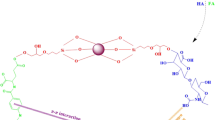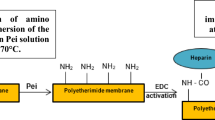Abstract
Plasma polypyrrole doped with iodine (PPy/I) and heparin (Hp) has been used as drugs in different ways in the human body. In this work, Hp was inserted into porous PPy/I to prepare biocompatible mixtures to potentially release Hp into the human body. The study was focused on the absorption and chemical interaction of Hp with PPy/I to find whether their structures suffer modifications in the carrying process. The absorption was performed by cryo-lyophilization immersing Hp in water with a 10:1 polymer/drug mass ratio. Once in contact, Hp went into the pores and partially coated the PPy/I surface. IR analyses of the mixtures on the surface showed that the functional Hp groups predominated over the polymer. The chemical interaction of both components was studied by XPS analyzing the energetic distribution of their atomic 1s or 2p orbitals. The results indicated that Hp interacted chemically with PPy/I losing the highest oxidized C1s, N1s and S2p chemical states in both components, forming new reduced ones with less multiple bonds or with more hydrogenated groups. S2p states were especially modified losing the most reactive states with 6 valences to form new more stable states with 2 valences. O1s orbitals behaved differently losing the most reduced chemical states forming new oxidized ones. These modifications suggest that the chemical reactivity of this PPy/I-Hp binary system was altered reducing the therapeutic capability of both components. This kind of studies should be done in all carrier–drug combinations to evaluate the possible chemical interaction between them.






Similar content being viewed by others
References
Walker MG, Shaw JW, Thomson GJL, Cumming JGR, Thomas ML (1987) Subcutaneous calcium heparin versus intravenous sodium heparin in treatment of established acute deep vein thrombosis of the legs: a multicentre prospective randomised trial. Br Med J 294:1189. https://www.jstor.org/stable/29526941
Hirsh J, Anand SS, Halperin JL, Fuster V (2001) Mechanism of action and pharmacology of unfractionated heparin. Arterioscler Thromb Vasc Biol 21:1094–1096. http://www.atvbaha.org
Xiong GM, Yuan S, Wang JK, Do AT, Tan NS, Yeo KS, Choong C (2015) Imparting electroactivity to polycaprolactone fibers with heparin-doped polypyrrole: modulation of hemocompatibility and inflammatory responses. Acta Biomater 23:240–2049. https://doi.org/10.1016/j.actbio.2015.05.003
Stewart EM, Liu X, Clark GM, Kapsa RMI, Wallace GG (2012) Inhibition of smooth muscle cell adhesion and proliferation on heparin-doped polypyrrole. Acta Biomater 8:194–200. https://doi.org/10.1016/j.actbio.2011.07.029
Garner B, Georgevich A, Hodgson AJ, Liu L, Wallace GG (1999) Polypyrrole-heparin composites as stimulus-responsive substrates for endothelial cell growth. J Biomed Mater Res 44(2):121–129
Garner B, Hodgson AJ, Wallace GG, Underwood PA (1999) Human endothelial cell attachment to and growth on polypyrrole-heparin is vitronectin dependent. J Mater Sci Mater Med 10:19–27. https://doi.org/10.1023/A:1008835925998
Meng S, Rouabhia M, Shi G, Zhang Z (2008) Heparin dopant increases the electrical stability, cell adhesion, and growth of conducting polypyrrole/poly(l, l-lactide) composites. J Biomed Mater Res A 87A(2):332–344. https://doi.org/10.1002/jbm.a.31735
González-Torres M, Cruz-Cruz GJ, Sánchez-Mendieta V, Gómez-Jiménez LM, González-Salgado F, Mondragón-Lozano R, Olayo-González MG (2017) Dapsone uptake and release from plasma polypyrrole for drug administration. Polym Bull 74:1761–1773. https://doi.org/10.1007/s00289-016-1803-3
Cruz GJ, Olayo MG, López OG, Gómez LM, Morales J, Olayo R (2010) Nanospherical particles of polypyrrole synthesized and doped by plasma. Poly 51:4314–4318. https://doi.org/10.1016/j.polymer.2010.07.024
Cruz GJ, Gómez LM, Gonzalez-Torres M, Gonzalez-Salgado F, Basurto R, Colín E, Palacios JC, Olayo MG (2017) Polymerization mechanisms in plasma polyallylamine. J Mater Sci 52:1005–1013. https://doi.org/10.1007/s10853-016-0396-4
Crist BV (1998) Advanced peak-fitting of monochromatic XPS spectra. J Surf Anal 4:428–434
Cotton FA, Wilkinson G (1980) Quimica inorganica avanzada. Limusa, Mexico
Dean JA (1999) Lange ´s handbook of chemistry. McGraw-Hill, New York
Gómez LM, Cruz GJ, Olayo MG, Gonzalez-Torres M, Gonzalez-Salgado F, Lopez-Gracia OG (2014) Analysis of crosslinking in polypyrrole particles synthesized by plasma. Polym Bull 71:3275–3287. https://doi.org/10.1007/s00289-014-1249-4
González-Torres M, Olayo MG, Cruz GJ, Gómez LM, Sánchez-Mendieta V, González-Salgado F (2014) XPS study of the chemical structure of plasma biocopolymers of pyrrole and ethyleneglycol. Adv Chem ID 965920:1–8. https://doi.org/10.1155/2014/965920
Watts JF, Wolstenholme J (2003) An introduction to surface analysis by XPS and AES. Wiley, Westsussex
Acknowledgment
The authors thank CONACYT for the partial financial support of this work with the project FC-152 and for the doctor scholarship to M.R. Mejía-Cuero; to PROMEP for the post-doctoral fellowships to Maribel González-Torres and Lidia Ma. Gómez; and to Rafael Basurto and Jorge Pérez for their assistance in XPS and SEM analyses.
Author information
Authors and Affiliations
Corresponding author
Additional information
Publisher's Note
Springer Nature remains neutral with regard to jurisdictional claims in published maps and institutional affiliations.
Rights and permissions
About this article
Cite this article
González-Torres, M., Olayo, M.G., Gómez, L.M. et al. Chemical interactions of heparin in porous polypyrrole, an example of drug–carrier destructive interaction. Polym. Bull. 77, 375–385 (2020). https://doi.org/10.1007/s00289-019-02751-w
Received:
Revised:
Accepted:
Published:
Issue Date:
DOI: https://doi.org/10.1007/s00289-019-02751-w




